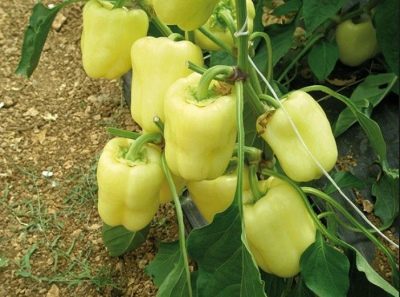
- Authors: TOM VAN DER HEIDE
- Name synonyms: Vedrana
- Year of approval: 2010
- Bush height, cm: 80
- Growth type: undersized, medium-sized
- Fruit shape: cuboid
- Fruit weight, g: 180-220
- Fruit color: in technical ripeness greenish-white, in biological ripeness - light red to red
- Ripening terms: early
- Fruit size, cm: 9 x 13
Vedrana pepper, which has Dutch roots, has enjoyed a well-deserved popularity for 10 years now. It is happily harvested for the winter, and is also often used for fresh summer dishes. This hybrid of bell pepper is considered by many experts to be the standard in terms of early maturity, quality and productivity.
Description of the variety
The large-fruited hybrid Vedrana F1 (Vedrana) was bred by the famous company Enza Zaden, which has its headquarters in Holland. In 2010 it was entered into the Russian register of varieties. The originators recommend it for cultivation in greenhouse structures of the temperate zone, and in the southern territories, such as the Crimea, Kuban, it is grown on open ridges. This hybrid Dutch variety has a high yield and excellent marketability. The plant is quite powerful, adapts quickly to different conditions. Large, thick-walled fruits can be kept fresh and transported over long distances.
Characteristics of the appearance of plants and fruits
Pepper Vedrana has strong, medium-sized bushes and powerful shoots. The height of the main trunk can reach 0.8 meters. The foliage with green leafy plates is good, there is a slight wrinkling on them.
The peppers are cuboid, slightly elongated, the fruit size is 9 by 13 centimeters, the average weight is 180-220 grams. When the peppers reach technical ripeness, they turn greenish-white, and upon reaching biological maturity, they turn from a light red to red hue. The walls are thick - 6-7 millimeters, the skin is glossy, shimmering.
Purpose and taste
The versatility of the Dutch pepper is illustrated quite widely. The product is actively used in various recipes for preparing homemade dishes. Stuffed peppers, side dishes, sauces, any preparations for the winter - this and much more can be prepared from the fruits of an interesting hybrid.
Ripening terms
Vedrana is a sweet pepper that belongs to the early ripening hybrid category. Fruiting starts after 95-105 days, if you count from the moment of seed germination.
Yield
The culture is considered to be high yielding. The average collection rate per square meter for open ground is 4.1-5.6 kilograms, and if you grow peppers under a film cover, it is 5.8-7.2 kilograms.
Growing regions
A hybrid variety from Holland is being successfully cultivated throughout Russia. Among the regions are the Northern and Northwestern, Central Black Earth and Central, Volgo-Vyatka, as well as the Northern Caucasus, the Volga region, the Urals, Siberia, the Far East.

To get a large and tasty harvest of pepper, you need to take care of the seedlings in advance. When growing pepper seedlings, you need to correctly determine the sowing time, pre-sowing seed treatment, prepare the necessary container and soil.
Growing and caring
Experts recommend sowing seed crops in early March. However, there are gardeners who start the season even earlier, and they plant seeds in February.The seeds of the hybrid are sold in specialized retail outlets, so no preparation or processing of the seed is required. The grains are already ready for planting. The grains are immersed by 0.8 cm. It is not necessary to make holes in the soil, you can simply sprinkle them with soil mixture. Seedlings are ready to be transplanted into the greenhouse in 50 days.
During the entire growing season, it is important to water Vedran peppers abundantly. And they also need hilling with damp earth. This procedure will help strengthen the roots and protect against lodging. Vedrana is equally successfully cultivated in the field and in greenhouse conditions.

To harvest a tasty and rich harvest of pepper, you need to comply with all the conditions of agricultural technology, and proper care begins with planting plants. Before planting pepper in open ground, it should be prepared. It is also important to take care of the seedlings and planting space in advance.




For good growth of pepper bushes and active fruiting, you need to regularly apply mineral and organic fertilizing to the soil. It is necessary not only to choose the right formulations, but also to use them at the right stage in the development of culture. The frequency of top dressing is always individual. It depends directly on the composition of the land on your site. The poorer the soil composition, the more often you will need to feed the pepper.
Disease and pest resistance
The culture is distinguished by strong immunity, but the hybrid is especially resistant to TMV - the tobacco mosaic virus.
This vegetable can be grown both hydroponically and using organic farming technologies.

Pepper is one of the most common vegetables in home gardens. This culture is quite stable and unpretentious. However, under certain conditions, this plant can suffer from infections and harmful insects. Before treating peppers for diseases or pests, you need to find out the cause of the problem, otherwise the treatment may be ineffective.





















































































